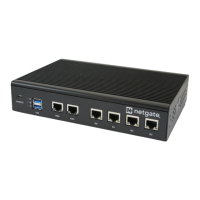Product Manual, TNSR 19.02
TNSR WAN/Internet Interface The TNSR WAN interface is used by TNSR to connect to the Internet.
A WAN interface will have a Public IP Address assigned and it will be attached to a subnet that has
a route to an Internet Gateway in its Route Table.
TNSR LAN/Private Interface The TNSR LAN interface connects TNSR to a private Subnet in the Vir-
tual Network. The instances in the private subnet do not have their own Public IP Addresses and
the Route Table for the subnet does not have a route to an Internet Gateway, but instead has a
route to the TNSR LAN interface.
Instances on the private subnet will use TNSR as their gateway to the Internet.
Each of the three network interfaces resides on a distinct subnet.
The examples in this guide use the following configuration:
Table 5: Example Azure Network Configuration
Item Value
Virtual Network Address Space 10.5.0.0/16
WAN Subnet 10.5.0.0/24
LAN Subnet 10.5.1.0/24
Management Subnet 10.5.2.0/24
In a real production Virtual Network, the TNSR instance may have more than one WAN interface and/or more than
one LAN interface. The concepts covered in this guide can be extended to additional interfaces.
There are some needed flags that cannot be configured using Azure Portal. This guide will cover all necessary steps
using azure-cli.
Launch an Instance
Now launch an instance of TNSR:
1. Install azure-cli. Instructions can be found at https://docs.microsoft.com/en-us/cli/azure/install-azure-cli?
view=azure-cli-latest
2. Login to your Azure account running:
$ az login
3. Configure the default location.
$ az configure --defaults location=centralus
4. Create a resource group to be used to store all TNSR related objects if it does not already exist.
$ az group create -n TNSR-Resource-Group
5. Create Virtual Network and Subnets.
$ az network vnet create \
-n TNSR-VNet \
-g TNSR-Resource-Group \
--address-prefixes 10.5.0.0/16
$ az network vnet subnet create \
-g TNSR-Resource-Group \
--vnet-name TNSR-VNet \
(continues on next page)
1.2. Cloud Platforms 50

